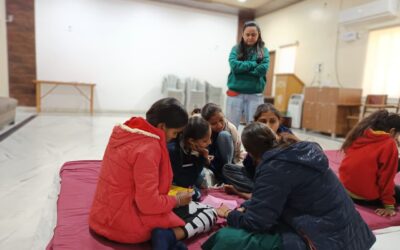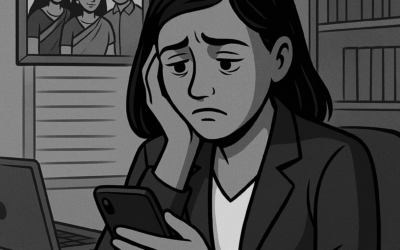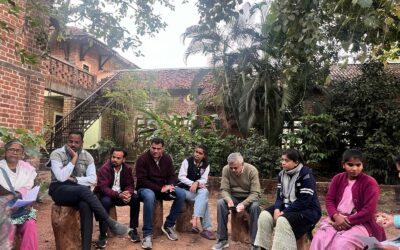Manthan was a transformative experience for me, offering not only a glimpse into rural India’s struggles but also profound lessons about collective action, empowerment, and the power of cooperation. Manthan is directed by Shyam Benegal. It takes us to a small village in Gujarat’s Kheda district, where the establishment of a dairy cooperative serves as the backdrop for a powerful social movement. The film, which mirrors the real-life Anand dairy movement (known today as Amul), goes beyond the narrative of economic change and dives deep into the intricate dynamics of power, caste, and gender.
Milk And Cooperation
The central theme of Manthan is the cooperative model, a system designed to empower farmers by giving them ownership over their production. In the film, Dr. Rao (played by Dr. Girish Karnad, many claim that the character traits are loosely based on Dr. Verghese Kurian himself – the man behind India’s White Revolution), a young veterinary doctor, arrives in a rural village with the aim of setting up a milk cooperative. The idea is simple yet revolutionary. Instead of selling their milk to exploitative middlemen like Gangaram Mishra Diary (portrayed by Amrish Puri), the villagers would collectively own and run a dairy cooperative, ensuring fair prices and equitable profits.
One of the most important takeaways from Manthan is how powerful the cooperative model can be in transforming not just economies, but entire communities. It teaches us that when people have a stake in their own enterprise, they take pride in their work and contribute more actively toward its success. This is a crucial lesson for modern development initiatives, especially those focusing on empowering marginalized communities.
Another powerful aspect of the film is its portrayal of caste dynamics and the challenges Dr. Rao faces in creating a truly inclusive cooperative. Bhola (played by Naseeruddin Shah), the leader of the Harijan (Dalit) community, is initially reluctant to join the cooperative, fearing that the upper-caste villagers will dominate and exploit it, as they have done with other resources. This skepticism reflects the deep-seated divisions in Indian society, where caste often dictates power and access to resources.
Caste And Cooperative
What I found incredibly insightful is how Manthan handles these caste tensions. The film doesn’t shy away from showing the complexities of village life, where caste is an invisible yet all-powerful force shaping interactions. Dr. Rao’s insistence on making the cooperative inclusive, despite the challenges, sends a powerful message about the need for equality in development. When Bhola eventually wins the cooperative election, defeating the upper-caste Sarpanch, it’s not just a victory for the cooperative but a symbolic win for the marginalized. This taught me that real progress can only happen when all sections of society, especially those who have been historically oppressed, are included in the decision-making process.

Throughout the movie, Dr. Rao and his team face intense opposition from the village elites, particularly Mishra and the Sarpanch (played by Kulbhushan Kharbanda). These local power brokers, who have long profited from exploiting the villagers, see the cooperative as a threat to their control and do everything they can to sabotage it. From spreading false rumours to orchestrating personal attacks on Dr. Rao, they go to great lengths to maintain the status quo.
In image – Mishra and Sarpanch, key antagonists of the movie
Those who hold power are not likely to give it up without a fight, and any movement that seeks to empower the oppressed will inevitably face pushback. But the film also shows that perseverance and solidarity can overcome these challenges.
Despite the setbacks and resistance, Dr. Rao and the villagers continue to work toward their shared goal, and their eventual success is a testament to the power of collective action.
Women Of Manthan
A key element of the film that resonated with me is the role of women in driving social change. In Manthan, women are not just passive observers but active participants in the cooperative movement. Bindu (Smita Patil), in particular, stands out as a symbol of female empowerment. At the beginning of the film, she is portrayed as a vulnerable young mother, abandoned by her husband and at the mercy of village norms. However, as the cooperative begins to take shape, Bindu becomes more involved, eventually emerging as one of its strongest supporters.
In rural India, women are often responsible for managing cattle and producing milk, yet their contributions are undervalued, and they rarely have a say in financial decisions. By involving women in the cooperative, Manthan shows how economic empowerment can lead to social empowerment. The women in the village, once voiceless and marginalized, begin to assert their rights, challenge patriarchal norms, and contribute meaningfully to their families and community.

Change From Within
Beyond the economic and social lessons, Manthan also offers insights into the importance of community-driven change. One of the most significant moments in the film is when Dr. Rao, disheartened by false allegations and personal attacks, contemplates leaving the village. It’s at this point that Bhola and Bindu step up, continuing the work of the cooperative in Dr. Rao’s absence. This is a pivotal moment in the film because it shows that real change must come from within the community.
For me, this was one of the most important lessons of the movie. While external support and leadership are essential, lasting change can only happen when the people themselves take ownership of the movement. Dr. Rao’s success lies not in what he does for the villagers, but in how he empowers them to do it for themselves. This is a critical point for anyone working in development or social change today.
True empowerment is about equipping people with the tools and knowledge they need to take charge of their own destinies.

Conclusion
Manthan is more than just a film about a dairy cooperative. It’s a powerful commentary on social justice, empowerment, and the transformative potential of collective action. The lessons I have drawn from the film are profound: the power of ownership, the importance of inclusivity, the need for perseverance, and the critical role of women in driving social change. As I reflect on these learnings, I am reminded that the issues highlighted in Manthan: economic exploitation, caste discrimination, and gender inequality are not unique to rural India. They are global issues, and the solutions offered by the film are cooperation, unity, and community-driven change are universal.
In a world that often feels divided, Manthan reminds us of the power of coming together to work toward a common goal. It teaches us that real progress happens when people, especially the marginalized, are given control over their own lives and destinies. This is a lesson that we can all benefit from, no matter where we are or what challenges we face.
For the film to be made, 5,00,000 farmers financed the production, contributing 2 rupees each, making it the first ever crowdfunded Indian film. The film was showcased in classics in the Cannes Film Festival in 2024.




0 Comments